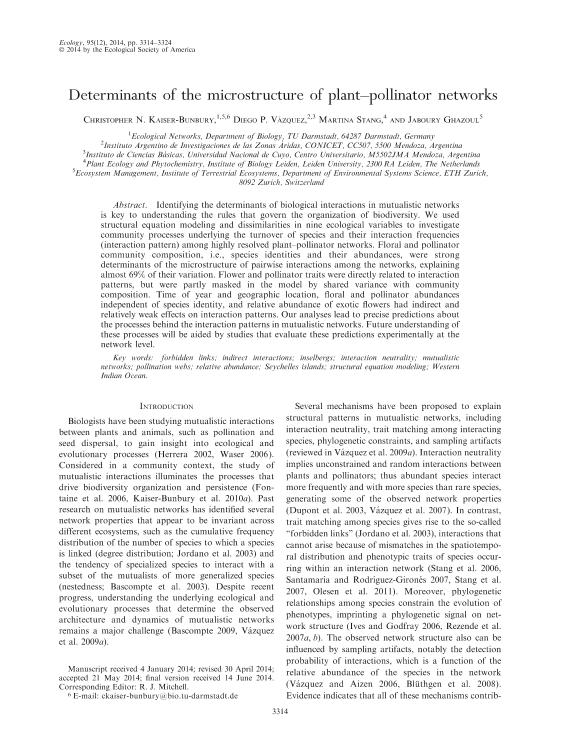Mostrar el registro sencillo del ítem
dc.contributor.author
Kaiser Bunbury, Christopher N.
dc.contributor.author
Vazquez, Diego P.

dc.contributor.author
Stang, Martina
dc.contributor.author
Ghazoul, Jaboury
dc.date.available
2019-09-23T17:15:04Z
dc.date.issued
2014-12
dc.identifier.citation
Kaiser Bunbury, Christopher N.; Vazquez, Diego P.; Stang, Martina; Ghazoul, Jaboury; Determinants of the microstructure of plant-pollinator networks; Ecological Society of America; Ecology; 95; 12; 12-2014; 3314-3324
dc.identifier.issn
0012-9658
dc.identifier.uri
http://hdl.handle.net/11336/84128
dc.description.abstract
Identifying the determinants of biological interactions in mutualistic networks is key to understanding the rules that govern the organization of biodiversity. We used structural equation modeling and dissimilarities in nine ecological variables to investigate community processes underlying the turnover of species and their interaction frequencies (interaction pattern) among highly resolved plant-pollinator networks. Floral and pollinator community composition, i.e., species identities and their abundances, were strong determinants of the microstructure of pairwise interactions among the networks, explaining almost 69% of their variation. Flower and pollinator traits were directly related to interaction patterns, but were partly masked in the model by shared variance with community composition. Time of year and geographic location, floral and pollinator abundances independent of species identity, and relative abundance of exotic flowers had indirect and relatively weak effects on interaction patterns. Our analyses lead to precise predictions about the processes behind the interaction patterns in mutualistic networks. Future understanding of these processes will be aided by studies that evaluate these predictions experimentally at the network level.
dc.format
application/pdf
dc.language.iso
eng
dc.publisher
Ecological Society of America

dc.rights
info:eu-repo/semantics/openAccess
dc.rights.uri
https://creativecommons.org/licenses/by-nc-sa/2.5/ar/
dc.subject
Forbidden Links
dc.subject
Indirect Interactions
dc.subject
Inselbergs
dc.subject
Interaction Neutrality
dc.subject
Mutualistic Networks
dc.subject
Pollination Webs
dc.subject
Relative Abundance
dc.subject
Seychelles Islands
dc.subject
Structural Equation Modeling
dc.subject
Western Indian Ocean
dc.subject.classification
Ecología

dc.subject.classification
Ciencias Biológicas

dc.subject.classification
CIENCIAS NATURALES Y EXACTAS

dc.title
Determinants of the microstructure of plant-pollinator networks
dc.type
info:eu-repo/semantics/article
dc.type
info:ar-repo/semantics/artículo
dc.type
info:eu-repo/semantics/publishedVersion
dc.date.updated
2019-08-27T18:36:36Z
dc.journal.volume
95
dc.journal.number
12
dc.journal.pagination
3314-3324
dc.journal.pais
Estados Unidos

dc.description.fil
Fil: Kaiser Bunbury, Christopher N.. Ecological Networks; Alemania
dc.description.fil
Fil: Vazquez, Diego P.. Consejo Nacional de Investigaciones Científicas y Técnicas. Centro Científico Tecnológico Conicet - Mendoza. Instituto Argentino de Investigaciones de las Zonas Áridas. Provincia de Mendoza. Instituto Argentino de Investigaciones de las Zonas Áridas. Universidad Nacional de Cuyo. Instituto Argentino de Investigaciones de las Zonas Áridas; Argentina
dc.description.fil
Fil: Stang, Martina. Leiden University; Países Bajos
dc.description.fil
Fil: Ghazoul, Jaboury. Institute of Terrestrial Ecosystems; Suiza
dc.journal.title
Ecology

dc.relation.alternativeid
info:eu-repo/semantics/altIdentifier/url/https://esajournals.onlinelibrary.wiley.com/doi/abs/10.1890/14-0024.1
dc.relation.alternativeid
info:eu-repo/semantics/altIdentifier/doi/http://dx.doi.org/10.1890/14-0024.1
Archivos asociados
